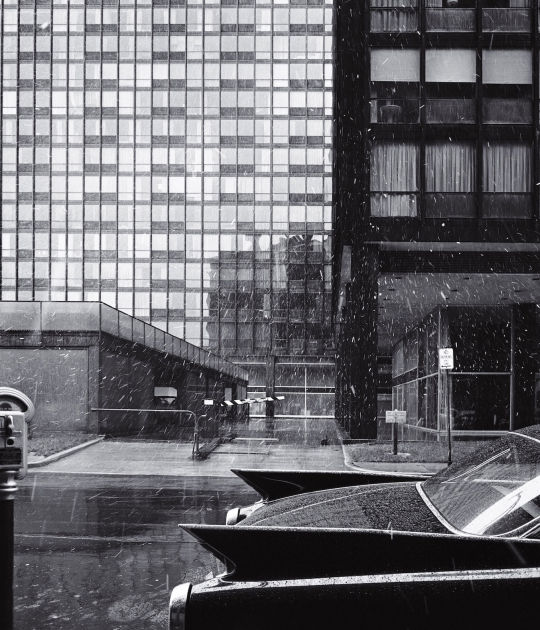Ana Amado is the first woman photographer in this series. I met her work, five years ago, for her collaboration in a spectacular project, "Spanish Dream", images that quickly traveled the world, were awarded and published all over the planet, presenting a compromised vision of the consequences of the bubble real estate. That work already spoke in depth about her personality, her interests and her social commitment.
Her previous and subsequent work, speaks of a trajectory that has put her objective in the image showing a clear influence by the painting and the graphic arts. In many of her works the need to make a narrative is discovered, where people take an important role. Architecture as scenery to talk about places, spaces in which people interact with each other or with space.
Ana Amado is a woman photographer who recognizes the need to photograph powerful places, more than spaces, in most of her images. Even when people are absent in their shots, the intensity of their black and white images is almost unreal beauty. The everyday becomes iconic and her images about iconic make us think that they were always something everyday, timeless.
Her previous and subsequent work, speaks of a trajectory that has put her objective in the image showing a clear influence by the painting and the graphic arts. In many of her works the need to make a narrative is discovered, where people take an important role. Architecture as scenery to talk about places, spaces in which people interact with each other or with space.
Ana Amado is a woman photographer who recognizes the need to photograph powerful places, more than spaces, in most of her images. Even when people are absent in their shots, the intensity of their black and white images is almost unreal beauty. The everyday becomes iconic and her images about iconic make us think that they were always something everyday, timeless.
What led you to the photograph?
I showed a very early interest in the arts. Since she was a child she drew and painted constantly. In adolescence I also discovered that fascinating artifact that is the camera. In any case, my inclination continued to be more graphic and pictorial for a few years, in fact I entered the fine arts in Cuenca, although I would soon abandon it for the architecture cart. I made many photographs during the years of my career. It was a basic instrument for project subjects, above all. But I not only took photos of places and models, but I started experimenting with the camera, analog at the time. It would be later, once I went digital, having finished my degree, which, in a somewhat casual way at first, I began to photograph the first works of fellow architects.
Why architectural photography?
Although I do not only photograph architecture, I began to dedicate myself professionally to photography in that way, as I commented, photographing works of my fellow architects. I suppose that my training as an architect has also influenced me to be "specialized", so to speak, in this field.
A photographer that you consider a reference?
The list would be long if we talk about photography in general. Speaking of photographers who have been referents in my way of looking at architecture, undoubtedly Walker Evans, influenced in turn by Atget. The New Topographics and the later Düsseldorf School drank from the same waters, and they are still key in today's photography. Also the great photographers of the Modern Movement, especially Ezra Stoller, Julius Schulman, Lucien Hervé. Kindel, in Spain. But I consider myself eclectic, and my first influences have come from painting and graphic arts. There are many other current photographers that has to do with the architecture that I admire and follow his work: Aitor Ortiz, Hélène Binet, Nadav Kander, Hiroshi Sugimoto, Iwan Baan, ...
Build photography, ideas, inspiration? What do you prefer to capture spaces or create places?
It depends on what kind of reporting you are doing. I face architecture differently if I'm doing a "descriptive" report, a commission, or I'm carrying out a personal report, in which I can use architecture as a backdrop for things that happen in it. In the first case, I try to build a visual story capable of counting the building, so that you can get an idea of the place without having been in it. In this case, the idea is to capture the space and translate it with the least possible filter, although your point of view is always there.
In the second case, when I develop a personal photographic project, it is very common for architecture to play some role in it. As a creator, I am increasingly interested in the social dimension of architecture. I feel more comfortable photographing the life that happens in the architecture we create and how that life transforms the architecture that contains it. And sometimes, I intervene and stage: for example in a project I did with 2 other fellow architects (Luz Paz and Marta Marcos), "Spanish Dream", we intervened the places that I photographed, recreating domestic scenes in works stopped in construction, and in others that I am developing right now too.
Your first camera? And now?
An analog Canon SLR, I do not remember the model. Now I shoot with 2 full digital Nikon Frame.
Is there a photograph that you would have or would like to make?
The photo of the Stahl House by Julius Schulman ... and many more.



































